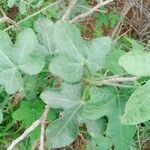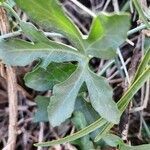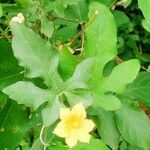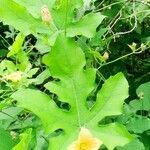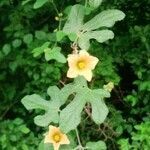Climber or trailer to 3 m.; rootstock perennial, woody, the roots also forming subspherical root-tubers distinct from the stem-base; basal stem gnarled, rather woody; aerial stems annual, herbaceous, sometimes tinged purplish or brownish, ribbed, sparsely to densely pubescent.. Leaves variable; blade triangular-ovate, ovate-or broadly ovate-cordate in outline, obscurely sinuate-dentate or almost entire to rather sharply dentate or lobulate, acute to rounded or slightly retuse and apiculate, glabrous or soft-pubescent especially beneath on the nerves, or punctate and sometimes scabrid, 35–135 mm. long, 26–135 mm. broad, unlobed or shallowly to deeply palmately 3–5(–7)-lobed; lobes triangular or ovate to obovate-oblong, elliptic-ovate, oblong-lanceolate or linear-lanceolate, broadest or narrowed at the base, sometimes lobulate, with the central largest; petiole 4–50 mm. long, ± pubescent especially laterally with close fine forward-pointing hairs.. Tendrils simple.. Probracts glandular, spathulate, 3.5–4 mm. long, 1–2 mm. broad.. Male flowers 2–22 in usually solitary and unbranched racemes on 5–75 mm. long peduncles, coaxillary with a long-pedicellate solitary flower; pedicels of racemose flowers 3–25 mm. long, ebracteate or subtended by small fleshy glabrous bracts; receptacle-tube obconic, somewhat flared at the mouth, 3.5–7 mm. long; lobes lanceolate, filiform or subulate, 1–5 mm. long; corolla campanulate-obconic below, flared above, golden-orange to pale apricot-orange or salmon-coloured, rarely tinged purplish, brown-veined outside, with the lobes obovate, apiculate, 13–30 mm. long, 7–14 mm. broad, united in lower half to two-thirds; stamens 3.. Female flowers solitary on 2–9 mm. long stalks; ovary glabrous or pubescent, fusiform, 9–22 mm. long, 1.5–2.5 mm. across; receptacle-tube campanulate, 2–3 mm. long; lobes lanceolate or filiform, reflexed or spreading, 1–4 mm. long; corolla funnel-shaped, with the lobes 12–18 mm. long, 7–10 mm. broad, united in lower two-thirds.. Fruit on a 4–15 mm. long stalk, tomato-red, ovoid-ellipsoid or long-ovoid-ellipsoid, often shortly beaked, 36–81 mm. long, 14–30 mm. across.. Seeds broadly ovate in outline, lenticular, 6 × 3.5 × 2.5 mm.; testa fibrillose.. Fig. 8/1–7, p. 57.
Leaf-lamina 2·5–12·5 × 2·5–15 cm., very variable, narrowly to broadly ovate or pentagonal in outline, cordate, dark green, almost glabrous except on veins to shortly pubescent or ± scabrid-punctate above, paler, ± glaucous and almost glabrous to rather densely pubescent beneath, unlobed or shortly to very deeply palmately 3–5-lobed, the lobes ovate or triangular to elliptic, narrowly elliptic or oblanceolate, subentire to strongly sinuate-dentate, sometimes ± lobulate, acute to obtuse, rounded or sometimes retuse, apiculate, the central largest.
male flowers 4–20 in 0·5–9 cm. pedunculate racemes, usually co-axillary with a 5–70 mm. pedicellate solitary flower; bracts of racemose flowers small, 1–1·5 mm. long, glandular, often absent; pedicels 1–28 mm. long. Receptacle-tube 3·5–6·5 mm. long, obconic-campanulate, sparsely shortly hairy or subglabrous, lobes remote, 1·5–5·5 mm. long, dentiform, subulate or lanceolate. Corolla pale creamy yellow, salmon-pink or orange, veined with green, brown or purple, the lobes 1–3 × 0·5–1·5 cm., obovate, apiculate, united to above the middle.
A pumpkin family herb. It is a slender climber. It has annual climbing stems. It grows up to 6 m long. The stems are furrowed and hairy when young. The leaves are deeply lobed and look like fingers on a hand. The edges of the leaves have shallow teeth. The leaf shape can vary on the one plant. The flowers are separately male and female on separate plants. Male flowers are yellow and in clusters. The female flowers are small, yellow and occur singly. The fruit is oblong and about 2.5-5 cm long. It is bright red when ripe.
Prostrate or scandent perennial herb. Tendrils simple. Leaves petiolate, petioles sparsely to densely hispid with rather slender, recurved, straight or usually ad-pressed-ascending hairs, lamina ± setulose or hispid beneath, at least on veins. Corolla lobes 10-30 mm, obovate, apiculate. Fruits apically ± rostrate, acute. Flowers pale creamy yellow, salmon-pink or orange, veined with green, brown or purple.
Female flowers solitary; pedicels 2–20 mm. long; ovary 6–22 × 1–2·5 mm., fusiform, glabrous, receptacle-tube 1·5–3·5 mm. long, narrowly campanulate; lobes 1–4·5 mm. long, subulate to lanceolate; corolla as in male flowers, but rather narrower.
Fruit 3–8·5 × 1–3 cm., ovoid-ellipsoid to ellipsoid-cylindrical, often shortly rostrate, smooth, bright red when mature although sometimes remaining greenish towards the base; fruit-stalk 0·5–2·2 cm. long.
Sterns annual, arising from subligneous perennial rootstock with tuberiferous roots, prostrate or scandent, sometimes purple-tinged, sparsely to densely shortly pubescent.
Petioles 0·4–5 cm. long, very sparsely to densely rather finely pubescent with short ascending or spreading hairs.
Seeds 4·5–6·5 × 3–4 × 1·5–2·5 mm., broadly ovate in outline, ± compressed, lenticular.
Probracts small, 1·5–4 mm. long, obovate-rotundate to spathulate.
Tendrils simple.
